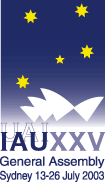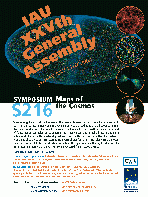IAU Symposium 216Maps of the CosmosSydney, July 14-17, 2003to be held in conjunction with theXXVth General Assembly of the International Astronomical Union
|
|||||||||||
Symposium OutlineMaps of the distribution of galaxies and of temperature fluctuations in the Cosmic Microwave Background (CMB) are fundamental in determining the structure, geometry and evolution of the Universe. The non-uniform distribution of galaxies in the local Universe has been apparent since the early surveys of Shapley, de Vaucouleurs and collaborators. Recent redshift and imaging surveys of huge numbers of galaxies have vastly improved our knowledge of large-scale structure and the evolution of galaxies. 2dF and SLOAN are recent examples of successful large redshift surveys. Together with dramatic new images of fluctuations in the CMB at millimetre wavelengths, and supernova-based distances to galaxies, the standard paradigm has shifted within the last decade to one in which the Universe appears dominated by "dark energy" rather than "dark matter". Many uncertainties remain in our picture of the Universe and its evolution. These include the form of the dark energy and the dark matter, the distribution of baryons, the formation of clusters, the formation of galaxies, the history of star-formation, and the role of star-formation in regulating metallicity, infall and the ionizing background radiation field. Many of these questions are being addressed by theoretical means including n-body and hydrodynamic simulations. Many observational projects are also underway. For example, maps of clusters of galaxies, maps of the distribution of Lyman-alpha absorbers, and maps of neutral hydrogen in the nearby and distant Universe will all help in understanding the distribution of the baryonic content of the Universe across the hot, warm and cool phases. High-redshift galaxy and QSO surveys are also underway to probe the structure of the Universe at early epochs. Deep observations of the CMB at arcmin resolution will probe the Universe at even earlier times. This symposium, which will be held alongside the 2003 IAU General Assembly in Sydney, will be timely in that this is a fast moving field where it is sometimes difficult for many researchers to keep up with the enormous advances being made by colleagues working in related fields. Results from the redshift and imaging surveys (e.g. 2dF, 2QZ, 6dF, SLOAN, 2MASS), X-ray results on galaxy and cluster evolution from XMM and Chandra, and results from the new generation of radio surveys (e.g. HIPASS and SUMSS) will all be peaking around 2003. We also expect preliminary results from deep redshift surveys from the largest telescopes (including VLT and Keck), and possibly the next generation of far-infrared surveys (SIRTF, ASTRO-F) to be available by the time of the symposium, as well as early results from the MAP CMB mission. A symposium which is able to draw together theoreticians and observers and researchers from several disciplines will be extremely valuable at this time.
Invited Speakers
Speaker Program (or PDF version here) Poster Program (or PDF version here)
Final Announcement
Arrival, Registration, Internet, Wireless, Poster informationPublication information. Unfortunately, due to the high number of poster papers, only papers from speakers will be accepted for the proceedings. Deadline Oct 31.
|
Scientific Organizing Committee:Danielle Alloin (Chile/ESO) Proceedings Editors:Matthew Colless
General Assembly PagesIAU2003 General Assembly Home Page Scientific Programe
Travel Grant Application Form
|
||||||||||
Information and Important DatesAll participants in the Symposium must register for the IAU General Assembly. Abstract submission should also be made via the General Assembly web pages. Travel funds are limited, and, following IAU regulations, priority will be given to qualified scientists for whom few or no other means of support are available. More information here.
|
|||||||||||
 |
|||||||||||
For further information, please email: iau216@csiro.au
IAU XXV General Assembly | IAU216 HOME PAGE | IAU216 Speaker Program | IAU216 Poster Program





